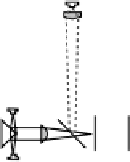Cryptography Reference
In-Depth Information
L2
base plate sitting on
precision tip/tilt aligner
to receiver
M2
alignment
laser
reference
clock
reference
photon
counter
random
number
generator
L1
source
module
spatial
filter
relay
optics
computer with
digital I/O card
pulse
driver
M1
AM
FM
Figure 9.3
The Alice compact breadboard transmitter. The digital I/O card delivers
a random 2-bit signal at 10 MHz synchronized to the reference clock. This signal is
used in the pulse driver for randomly firing one of four lasers in the miniature source
module. The four lasers are combined in a spatial filter using a conical mirror and relay
lens. This system produces pulses with 0.05 to 0.5 photons per pulse. The output of the
spatial filter is then transformed to a collimated beam with 2 mm FWHM and further
expanded in a x20 telescope (L1 and L2) to produce a near diffraction-limited 40 mm
beam. A precision translator with lens L1 allows for the fine focus adjustment. A bright
CW laser beam can be injected with an auxiliary mirror AM for alignment purposes
into the the same spatial filter as the faint pulses, while a calibration of the number
of photons per bit can be made by inserting mirror FM and measuring a reference
photocount. Mirrors AM, FM, M1 and M2 are gold coated for high reflectivity in the
infrared.
are followed by four photon-counting avalanche diodes. One polarizing beam
splitter is preceded by a 45
◦
polarization rotator (half-wave plate). Photons
detected in this channel are thus measured on the 45
◦
basis, while the other
polarizer allows measurement on the 0-90
◦
basis. Since the splitting of in-
coming photons to the two analyzers by the beam splitter is truly random, no
random number sequence is required on the receiver side, at the expense of
more photodetectors.
The time of arrival of each photodetection is recorded in the computer
using a two-channel time digitization card (Guide Technology GT654). Thus
the four detectors' outputs are combined into the two channels with a delay
of 5 ns. The delay is then used to discriminate between the two measurement
bases. The overall optical detection efficiency of the receiver is about 16%,
and the timing jitter was smaller than 1 ns.
Timing and synchronization
The two separate computers were linked
via modems operating over a standard mobile telephone link (9.6 Kbaud
bit rate). Local oven-stabilized 10 MHz clocks were synchronized to better





















